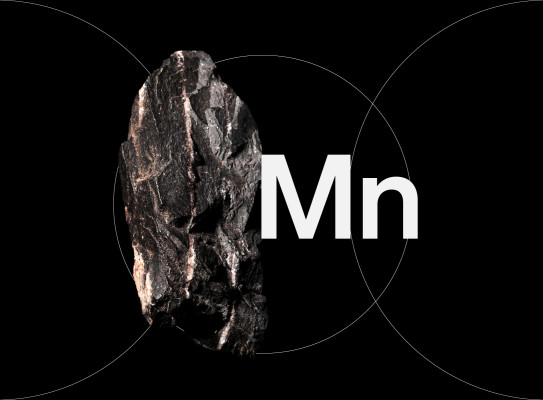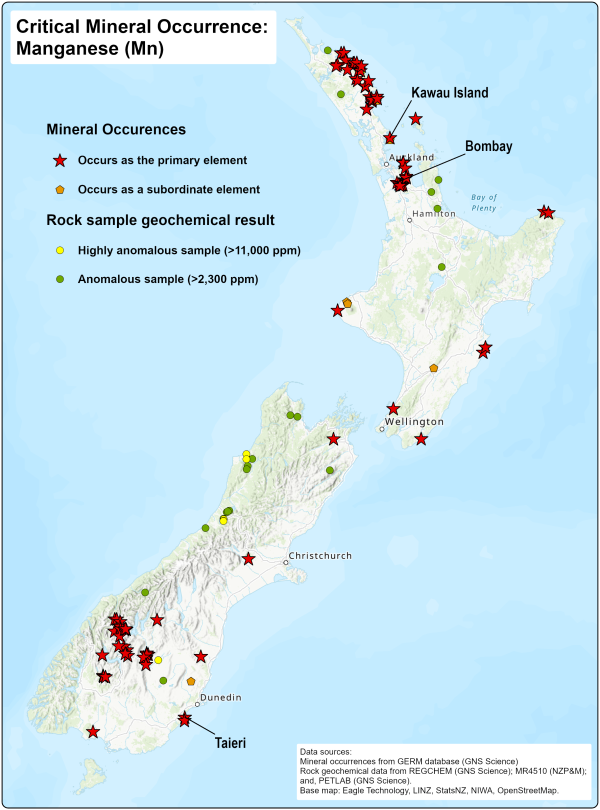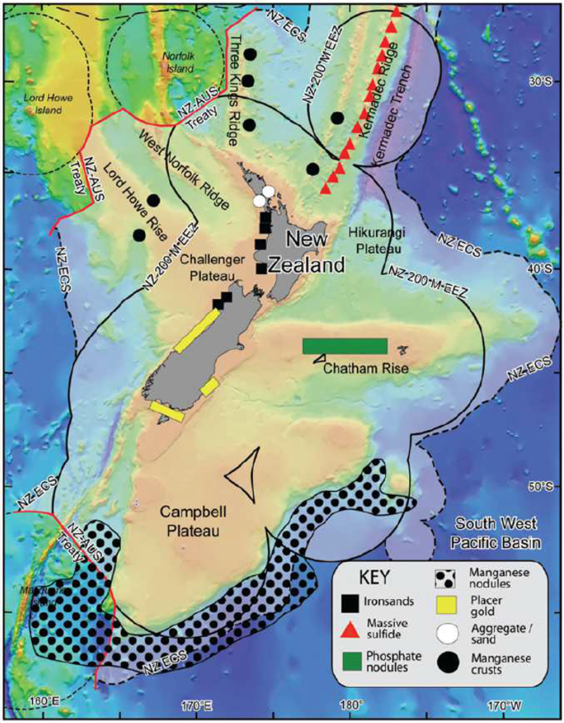Manganese

Manganese (Mn) is an essential industrial metal with widespread applications in steel production, battery technology, and chemical industries. It is a critical mineral due to its role in strengthening materials, enabling clean energy technologies, and supporting modern infrastructure.
Manganese in New Zealand
New Zealand Occurrences of Volcanogenic Mn Deposits
Small manganese deposits occur in association with spilitic red-rock suite rocks in the Permian–Jurassic greywacke and argillite of the North Island (Waipapa Group and Torlesse Supergroup), as well as their metamorphosed equivalents in the South Island (Haast Schist). The red rocks consist of mafic lava, chert, jasperite and volcaniclastic argillite. The manganese deposits are usually hosted by red argillite and chert.
New Zealand’s first metal-mining operation was the extraction of manganese from an adit on Kawau Island in 1842. Subsequent production was mainly from deposits in Northland, Bombay (South Auckland) and Taieri Mouth (Otago), continuing intermittently until 1960 to produce a total of 26,102 t of ore, mostly at grades of 40–50% metallic manganese.

-
Offshore Ferromanganese Nodules
Ferromanganese nodules (also known as polymetallic nodules are accretions of manganese oxides and iron oxyhydroxides up to tens of centimetres in diameter, onto which metals such as cobalt (Co), nickel (Ni), copper (Cu), molybdenum (Mo), lithium (Li), titanium (Ti) and REE, as well as yttrium (REY) are scavenged. These form on or just below the sea floor on the abyssal plains of the deep ocean via precipitation from either ocean water or sediment pore water (e.g. Hein et al. 2020). Ferromanganese nodules cover vast areas of the global ocean floor, particularly in deep water (~3500–6500 m, below the carbonate compensation depth) where sedimentation is slow and bottom waters are well oxygenated.
A large nodule field abuts the southeastern slope of the Campbell Plateau and extends into the Southwest Pacific Basin, beneath the Deep Western Boundary Current (DWBC) and Antarctic Circumpolar Current (ACC). The field is inferred to be some 300–500 km wide in areas west of 174°E, between 59 and 48°S. Further east, it narrows to ~200 km at 55°S and 120 km at 49°S as the bottom currents are deflected eastward (Wright et al. 2005). Much of this field is within New Zealand’s EEZ and/or Extended Continental Shelf. No detailed studies of the distributions or compositions of nodules have been undertaken in other sectors of the field, adjacent to the southern or western Campbell Plateau. Estimates of seafloor densities vary here, from >75% to patchier distributions of 25–75%.
Based on an average nodule size of 3 cm, mass of 0.3 kg and seafloor density of 50%, it is estimated a total mass of 2 x 109 kg for ferromanganese nodules within the 50,000 km2 northeast part of the Campbell field. Taking average compositions, these were equated to resources of 5 x 106 t of Ni, 2 x 106 t of Cu and 3 x 106 t of Co (of which 60–70% lies within New Zealand’s EEZ). These resources have been considered uneconomic, given commodity prices and recovery costs. The average combined Ni + Cu + Co contents for the Campbell nodules are below the ~2–3 wt% cut-off that has more recently been considered to define ‘resource-grade’ nodules. However, the areal density of nodules and concentrations of other critical metals needs to be considered for a robust and up-to-date assessment of economic potential for the Campbell field. The bulk abundances of a number of economically important metals (e.g. Li, Tl, W, Te, Pt) in the Campbell nodules are unknown and should be quantified as part of a more complete assessment of this resource.

Geological Sources of Manganese
- Manganese occurs in several geological settings:
- Manganese Nodules & Crusts – Rich deposits on the ocean floor, particularly in the Pacific Ocean (e.g., Clarion-Clipperton Zone).
- Sedimentary Manganese Deposits – Formed in ancient marine environments, often associated with iron deposits (e.g., South Africa, Gabon).
- Volcanogenic & Hydrothermal Deposits – Found in submarine volcanic settings, such as those linked to seafloor hydrothermal vents.
Key Uses of Manganese
Steel and Alloys - Over 90% of manganese is used in steelmaking, where it improves strength, toughness, and corrosion resistance. It is a key component in ferromanganese and silicomanganese alloys.
Battery Technologie - Manganese is crucial for lithium-ion and alkaline batteries, including high-performance nickel-manganese-cobalt (NMC) cathodes used in electric vehicles (EVs) and energy storage.
Chemical and Industrial Uses - Manganese compounds are used in fertilisers, pigments, water treatment, and electronics.
Human Health - Manganese is a trace element vital for enzyme function, bone development, and metabolism.
Exploration and Mining
Manganese is mined globally, with major producers including South Africa, Australia, Gabon, and Brazil. Emerging interest in deep-sea mining targets manganese nodules as a potential future supply source.
Manganese in the Future
With increasing demand for electric vehicles, energy storage, and sustainable steel production, manganese remains a key resource for the transition to a low-carbon economy. Ongoing research explores its role in next-generation battery chemistries and green steel technologies.
Manganese’s critical role in industry, energy, and technology makes it an important mineral for geological explorers and researchers.
Additional reading
Carter L. 1989. New occurrences of manganese nodules in the Southwest Pacific Basin east of New Zealand. New Zealand Journal of Marine and Freshwater Research. 23(2):247–253. https://doi.org/10.1080/00288330.1989.9516361(external link)
Carter L, McCave IN. 1997. The sedimentary regime beneath the Deep Western Boundary Current inflow to the Southwest Pacific Ocean. Journal of Sedimentary Research. 67(6):1005–1017. https://doi.org/10.1306/D42686B2-2B26-11D7-8648000102C1865D(external link)
Graham IJ, Wright IC. 2006. The Campbell ferromanganese nodule field in the southern part of New Zealand’s Exclusive Economic Zone. In: Christie AB, Brathwaite RL, editors. Geology and exploration of New Zealand mineral deposits. Parkville (AU): Australasian Institute of Mining and Metallurgy. p. 339–347. (Australasian Institute of Mining and Metallurgy monograph series; 25).